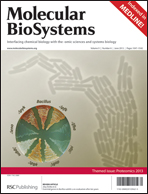Quantitative proteomics is an essential tool in proteome research since it enables measuring changes in protein abundance in response to biological perturbations. During the last few years, different quantitative strategies have been developed in proteomics to compare different experimental conditions, including label-free and isobaric chemical labeling approaches. Here we show that different quantitation techniques have an important influence on detected sample variability, and we use the combination of six different quantitation strategies to perform a proteome comparison of three different Mycoplasma pneumoniae strains (ldh knockdown, Δprkc, and wild-type). The integration of the different datasets indicates that the ldh knockdown strongly affects the abundance of ribosomal proteins and enzymes involved in the regulation of the cellular redox state, whereas the prkc deletion affects key cellular physiological processes such as protein and DNA synthesis, and cytoadherence.
You have access to this article
 Please wait while we load your content...
Something went wrong. Try again?
Please wait while we load your content...
Something went wrong. Try again?


 Please wait while we load your content...
Please wait while we load your content...